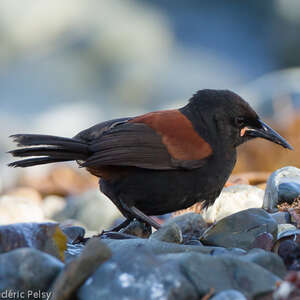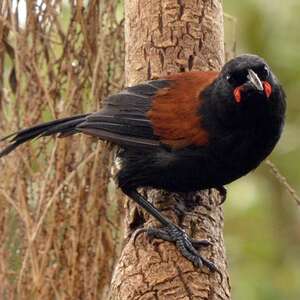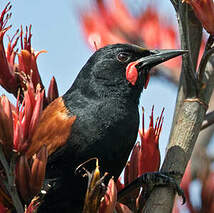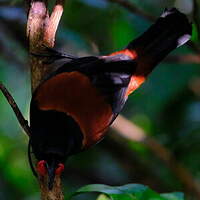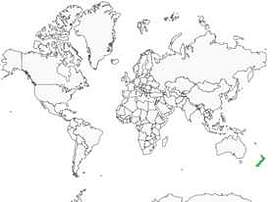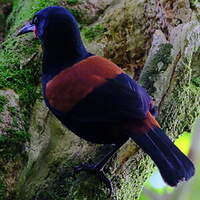North Island Saddleback
Philesturnus rufusater - Créadion de Lesson
Identification
The North Island Saddleback (Tieke in the Mãori culture) is endemic to the North Island. It has black plumage, with a reddish saddle on its back (hence its English name: Saddleback), red wattles that grow with age and a thin golden band on the leading edge of the saddle. Both sexes are alike, although males usually have more developed wattles than the same age females. Juveniles are alike, but their plumage is duller than adults, with dusty brown tips on the body feathers, and the gold band is absent. Immatures have small wattles.
Subspecific information monotypic species
Foreign names
- Créadion de Lesson,
- Tieke de Isla Norte,
- pássaro-selado-do-norte,
- Nordinsel-Sattelvogel,
- Noordelijke Zadelrug,
- nordövårtkråka,
- Nordsadelrygg,
- laločník sedlový,
- Nordø-saddelryg,
- tieke de l'illa del Nord,
- kurobród północny,
- Североостровная седлистая гуйя,
- ホクトウセアカホオダレムクドリ,
- 北岛鞍背鸦,
- nordövårtkråka,
- 北島鞍背鴉,
Voice song and call
The call is a loud cheet te-te-te-te emitted during the day. North Island Saddlebacks (Créadion de Lesson) have a territorial rhythmic song which is characterized by 2-4 introductory notes followed by a series of very stereotypical and repeated phrases. More than 200 different types of rhythmic songs have been recorded for male birds.
Habitat
It frequents islands, coastal and interior forests, particularly regrowth areas with a mix of shrubs and ferns, ranging from sea level to over 600 m altitude. It is especially associated with forest edges, and is present in Kahurangi, Paparoa and the Coromandel, but now confined to the North Island Saddleback.
Behaviour character trait
The North Island Saddleback is an extremely active bird, ranging from the forest floor up to the canopy.
It is often accompanied by other species. Pairs are monogamous and form long term bonds. Generally, they hold the same territory throughout their life and keep contact with each other through chirping and exchanging food. Their flight is not powerful, which limits their ability to travel. Juveniles, non-territorial in high density populations, are often seen feeding in small groups of 2-4. North Island Saddleback are frequently joined by other species, particularly yellowhead mohoua, endemic parakeets, and chestnut-collared rhipidures, that together form multi-species foraging groups during the non-breeding season. Chestnut-collared rhipidures are often seen year-round alongside North Island Saddleback searching for food, picking up invertebrates disturbed by their vigorous pecking.Flight
Dietfeeding habits
Reproduction nesting
The North Island Saddleback is a monogamous bird, with durable pairs and typical nesting from spring to summer.
The breeding season stretches from August to May. Females build a cup-shaped nest using vegetation in tree cavities, rock crevices, tree-fern crowns, epiphytic plants, and, more rarely, dense ground vegetation. Artificial nest-boxes are used on some islands. Clutch size ranges from 1 to 4 eggs which are oval in shape, usually pink-grey to grey-violet, and occasionally white with darker spots, mostly brown, mauve, or violet. Where food is abundant there can be up to four clutches in one season (generally 1 to 2 in stable populations). Incubation lasts 18 days, young leave the nest 22-27 days after hatching and are fully-fledged at 50-69 days old. Only the female incubates and both parents raise the young. The young become independent at around one year old.Geographic range
The North Island Saddleback, formerly very common on the islands of northern New Zealand, died out on the mainland around 1900. Its disappearance is due to deforestation and the introduction of predatory species. Only a natural population survived on the chicken island. This species is considered by some to be a subspecies of P. c. carunculatus. Birds were reintroduced to islands where predators (rats, ermines) had been previously eradicated: Whatupuke (1964), Red Mercury (1966), Cuvier (1968), Lady Alice (1971), Stanley (1977), Little Barrier (1984-1988), Tiritiri Matangi (1984), Kapiti (1987-1989).
Threats - protection
IUCN conservation status
concern
in the Wild
threatened
evaluated
The International Union for Conservation of Nature (IUCN) Red List of Threatened Species lists the North Island Saddleback (Créadion de Lesson) as Near Threatened.
Sources of information
- IOC World Bird List (v14.2), Gill, F and D Donsker (Eds). 2024-04-18.
- Handbook of Australian, New Zealand and Antarctic birds, 1: ratites to ducks., Marchant, S.; Higgins, P. J.
- Handbook of the birds of the world Vol.14, josep del Hoyo
- The field guide to the birds of New Zealand., Heather, B. D.; Robertson, H. A.
- xeno-canto, Sharing bird sounds from around the world,
- Wikipedia (English version),
Other sources of interest
 Specification sheet created on
04/08/2023 by Yann Cambon
Specification sheet created on
04/08/2023 by Yann CambonTranslation by AI Oiseaux.net
© 1996-2025 Oiseaux.net
- Accipitriformes
- Aegotheliformes
- Anseriformes
- Apodiformes
- Apterygiformes
- Bucerotiformes
- Caprimulgiformes
- Cariamiformes
- Casuariiformes
- Charadriiformes
- Ciconiiformes
- Coliiformes
- Columbiformes
- Coraciiformes
- Cuculiformes
- Eurypygiformes
- Falconiformes
- Galliformes
- Gaviiformes
- Gruiformes
- Leptosomiformes
- Mesitornithiformes
- Musophagiformes
- Nyctibiiformes
- Opisthocomiformes
- Otidiformes
- Passeriformes
- Pelecaniformes
- Phaethontiformes
- Phoenicopteriformes
- Piciformes
- Podargiformes
- Podicipediformes
- Procellariiformes
- Psittaciformes
- Pterocliformes
- Rheiformes
- Sphenisciformes
- Steatornithiformes
- Strigiformes
- Struthioniformes
- Suliformes
- Tinamiformes
- Trogoniformes

